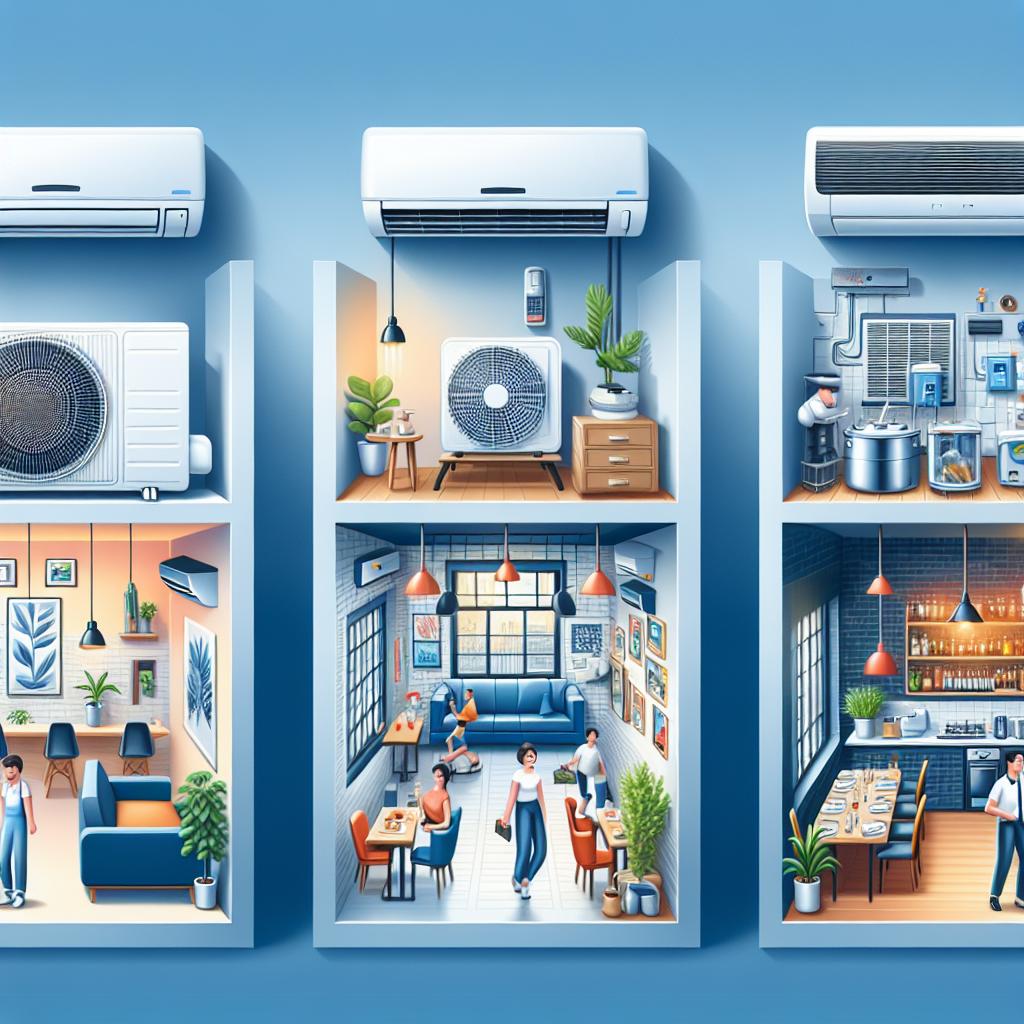Introduction
In the realm of commercial climate control, the demand for efficient and adaptable air conditioning solutions continues to grow. Among the myriad options available, mini split air conditioning systems have emerged as a versatile choice, offering both flexibility and performance across a variety of settings. However, with advancements in technology and a multitude of models to consider, selecting the right mini split AC for your specific commercial application can be a daunting task. This guide aims to demystify the process by exploring the different technologies available, understanding their unique benefits, and ultimately helping businesses make informed decisions that cater to their unique heating and cooling needs. Whether you’re managing a bustling restaurant, an office space, or a retail outlet, the right mini split AC system can significantly enhance comfort while optimizing energy efficiency. Join us as we navigate the key considerations that will lead you to the ideal solution for your commercial environment.
Understanding the Basics of Mini Split AC Systems for Commercial Use
Mini split AC systems are a versatile solution tailored for commercial applications, offering efficiency and flexibility that traditional HVAC systems often lack. They consist of two main components: an indoor unit and an outdoor unit, which work together to provide heating or cooling without the extensive ductwork. This type of system is ideal for various businesses, from small offices to large retail spaces, because they can be easily zoned. Individual control over temperatures in different areas enhances comfort for both staff and customers, ultimately leading to improved productivity and satisfaction.
When selecting a mini split AC system for commercial use, consider factors such as capacity, installation options, and energy efficiency. It’s essential to match the unit’s capacity with the size and usage of the space to avoid underperformance or excessive energy consumption. Additionally, options like single-zone units for smaller areas or multi-zone systems that can concurrently cool or heat multiple spaces should be evaluated based on the specific needs of the business. Detailed below are some key attributes to keep in mind:
| Feature | Importance |
|---|---|
| Energy Efficiency Rating (EER) | Lower operating costs and environmental impact |
| Noise Levels | Minimized disruptions in work or retail environments |
| Installation Flexibility | Conforms to various building layouts and design needs |
| Warranty and Support | Protection for your investment and peace of mind |

Key Factors to Consider in Choosing Mini Split AC Technology
When selecting a mini split AC system for commercial applications, various factors need to be taken into account to ensure optimal performance and efficiency. One of the key considerations is the capacity, which directly impacts the unit’s ability to cool or heat the space adequately. It’s critical to calculate the cooling load of the area to determine the right size. Oversized units may lead to short cycling, while undersized systems may struggle to maintain comfortable temperatures. Moreover, examining the energy efficiency ratio (EER) and seasonal energy efficiency ratio (SEER) is essential, as higher ratings indicate better energy performance and lower operational costs over time.
Additionally, installation factors and system design are paramount in making the right decision. Assessing the layout of the building can help determine the number of indoor units needed for balanced distribution of air. It’s also vital to consider the noise level of the units if the environment is sensitive to sound. Other considerations include the type of refrigerant used, as options like R-410A are more environmentally friendly and have higher efficiency than older models. Lastly, exploring brand reputation, warranty, and after-sales support can help ensure you are investing in a system that offers longevity and service reliability.
| Factor | Description |
|---|---|
| Capacity | Choose the right size based on cooling load calculations. |
| Energy Efficiency | Look for high EER and SEER ratings for cost-effective operation. |
| Noise Level | Select units with lower decibel ratings for quieter environments. |
| Refrigerant Type | Select environmentally-friendly options like R-410A. |
| Brand Reputation | Research reviews and ratings to ensure reliability. |

Comparing Different Mini Split AC Technologies for Varied Applications
When evaluating mini split AC technologies, it’s essential to understand their unique characteristics to match them with the specific requirements of commercial applications. Ductless mini splits are incredibly versatile, ideal for spaces where extending ductwork is impractical. They boast high energy efficiency and provide individual zoning, allowing for different temperature controls in separate rooms. Conversely, multi-zone systems cater to expansive commercial environments by connecting multiple indoor units to a single outdoor compressor. This setup not only conserves space but also enhances energy efficiency by allowing tailored cooling for individual areas based on their usage patterns.
Another technology gaining traction is the VRF (Variable Refrigerant Flow) system, which offers precise temperature control and exceptional energy savings, making it suitable for large buildings with varying occupancy levels. These systems can simultaneously heat and cool different zones, optimizing energy usage. Inverter technology is also worth noting, as it allows the compressor to operate at variable speeds, ensuring better temperature consistency while minimizing energy waste. Here’s a simple table comparing these technologies based on key features:
| Technology | Efficiency | Flexibility | Best For |
|---|---|---|---|
| Ductless Mini Splits | High | Moderate | Small office spaces |
| Multi-Zone Systems | Very High | High | Medium to large offices |
| VRF Systems | Exceptional | Very High | Large buildings |
| Inverter Technology | High | Moderate | Residential & commercial |

Best Practices for Installation and Maintenance of Mini Split Systems
To ensure the longevity and efficiency of mini split systems, proper installation is crucial. Always employ certified technicians to handle the installation. This guarantees that the unit is set up in accordance with the manufacturer’s specifications and local building codes. Key installation practices include:
- Choosing an appropriate location for the indoor and outdoor units to avoid obstructions and maximize airflow.
- Ensuring that the mounting brackets and pads are secure to minimize vibration noise.
- Sealing refrigerant lines and electrical connections to prevent leaks and enhance energy efficiency.
Maintenance is equally important for optimal performance. Regular check-ups can prevent costly repairs and ensure efficient operation. Recommended maintenance practices involve:
- Cleaning or replacing the air filters monthly to maintain air quality and system efficiency.
- Inspecting and cleaning the condenser coil at least twice a year to remove debris and improve heat exchange.
- Scheduling professional maintenance annually to check refrigerant levels, inspect electrical components, and test system performance.
Q&A
Guide to Selecting the Right Mini Split AC Technology for Different Commercial Applications: Q&A
Q1: What is a mini split AC system and how does it differ from traditional HVAC systems?
A1: A mini split AC system, also known as a ductless system, consists of an outdoor unit and one or more indoor units that transmit cooled or heated air directly into the space. Unlike traditional HVAC systems that rely on ductwork to distribute air, mini splits offer targeted comfort without the complexity of installation. Their flexibility in design makes them ideal for various commercial applications, from small offices to larger retail spaces.
Q2: Why should businesses consider using mini split systems?
A2: Mini split systems provide several advantages for businesses: they are energy-efficient, quieter than conventional systems, and allow for individualized temperature control in different areas. Additionally, their modular nature makes them easier to install and maintain, meaning businesses can save on installation costs and reduce downtime during implementation.
Q3: What commercial applications are best suited for mini split AC technology?
A3: Mini split AC technology shines in a variety of commercial settings, including small retail stores, restaurants, server rooms, and even multi-unit buildings like hotels and apartment complexes. Each setting can benefit from the ability to zone temperature controls, allowing for tailored climate management based on occupancy and activity levels.
Q4: How do I determine the right capacity for a mini split AC unit in my commercial space?
A4: To determine the appropriate capacity, you’ll need to conduct a load calculation, factoring in variables like square footage, insulation quality, number of windows, and local climate conditions. It’s often advised to consult with an HVAC professional for an accurate assessment, as the right capacity ensures efficiency and effective cooling while preventing unnecessary energy expenditure.
Q5: Are there different types of mini split systems available for various commercial applications?
A5: Yes! There are several types of mini split systems, including wall-mounted, ceiling-mounted, and multi-zone options. Wall-mounted systems are common in smaller spaces, while ceiling-mounted units work well in areas with higher ceilings or limited wall space. Multi-zone systems feature multiple indoor units connected to a single outdoor unit, allowing for extensive temperature control across larger commercial environments.
Q6: What features should I look for when selecting a mini split AC system?
A6: Key features to consider include energy efficiency ratings (SEER and HSPF), quiet operation, customizable zoning options, smart technology compatibility, and installation flexibility. Assessing warranties and after-sales support from manufacturers can also help ensure long-term reliability and satisfaction with your investment.
Q7: How can I maintain a mini split AC system to ensure optimal performance?
A7: Regular maintenance is vital for any HVAC system. For mini splits, this includes cleaning or replacing filters every few months, checking the outdoor unit for debris, and scheduling annual professional inspections to ensure efficiency and identify any potential problems early on. Proper maintenance can extend the lifespan of the units and keep your energy costs in check.
Q8: Are there any common misconceptions about mini split AC systems?
A8: One common misconception is that mini splits are only suitable for smaller spaces. While they excel in those environments, their scalability allows them to effectively serve larger areas as well. Another myth is that they cannot handle extremely hot or cold temperatures; in reality, many modern mini splits are designed to perform efficiently in a range of climate conditions, providing reliable comfort year-round.
Q9: What should I do if I’m unsure which mini split AC technology is right for my business?
A9: If you’re feeling overwhelmed, start by consulting with HVAC professionals who can assess your specific needs, evaluate your space, and help you explore the best options based on your unique commercial application. They can guide you through the tech specifications, zoning capabilities, and ideal capacity needed for your space, ensuring that you make an informed decision.
To Wrap It Up
selecting the right mini-split AC technology for your commercial application is not just a matter of comfort; it’s a strategic decision that can significantly impact efficiency, costs, and overall environment. By understanding the unique needs of your space—whether it’s a bustling restaurant, a serene office, or a dynamic retail environment—you can tailor your choice to enhance both the experience of your occupants and your operational effectiveness.
As technology continues to evolve, staying informed about the latest advancements in mini-split systems will empower you to make choices that are not only suitable today but also future-proof. So take the time to evaluate your options, consult with experts, and consider factors such as energy efficiency, installation logistics, and ongoing maintenance.
With the right selection in hand, you’ll be well on your way to creating a comfortable, productive atmosphere that meets the demands of your commercial space while embracing the benefits of mini-split innovation. Here’s to making optimal choices that ensure both your business and customers thrive in a climate-controlled environment tailored just for them.

